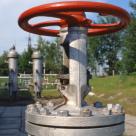May natural gas futures closed out last week at $2.089/MMbtu, down 5.2 cnts. The Henry Hub ICE cash day-ahead index was back below $2, coming in at $1.9802, down 8 cnts. Cash prices have now been hovering in the bottom-end of the $2 range for more than a month. U.S storage inventories are up to 2,479 Bcf, 60.5% over the five year average. Last year between the 2nd week of April and the beginning of storage withdrawals (during a hot summer with a lot of gas fired power generation), another 2,252 Bcf went into storage. If that happens this year, it would mean that the storage balance would top out at 4,631 Bcf – unfortunate since EIA tells us that capacity is about 4,200 Bcf. The implication is that storage inventories will max out capacity sometime in the early fall, basically hitting The Wall – with unknown consequences for natural gas markets. We don’t need no education. We need less gas or more demand.
Daily Energy Blog
Thursday’s RBN post closed out with the prospect of bad news for gas price bulls if EIA storage came in with some number like +56 bcf when expectations were for +45. So the EIA build turned out to be one notch higher at +57 bcf. True to form, the CME/NYMEX May contract dropped like a rock. See the Updata Candlestick-Volume chart below that again tells the story.
Yesterday April Natgas rolled off the board closing with still another 10 year low, and the third official day of April bidweek wrapped up a weak trading session. Day-gas cash prices are in the dog house. It is EIA storage day, and a higher than expected build could be on the way. There is nothing about the natural gas market that looks bullish. Nevertheless, there has been no price collapse. In fact, natty has been range bound for weeks now. Do we know any more than we did two months ago? Let’s put the current situation in a historical perspective.
Yesterday was still another day of lower natural gas cash prices and whipsawing futures prices. ICE cash Henry Hub was at $2.0748/MMbtu, down 6 cnts. At one point weekend Henry Hub printed $1.98. TGP-Z4 Marcellus came down 8 cnts to $1.9440. April futures ran up again to $2.33 about 10:30 before coming off the rest of the day, closing at $2.279. We’ve talked a lot about production gluts and potential storage overruns over the past two days. Perhaps it is good time to step back and look at the big picture of U.S. natural gas supply and demand. And what better way to do that than with BENTEK numbers.
Yesterday we looked at Tuesday’s natural gas price 13cnt whipsaw and the apparent resistance to prices below $2.26 or so. I closed that blog with a commitment to look again at the fundamentals for oversupply, maxed out storage capacity and the impending collision of natural gas prices with reality (for background see Whip it, Whip it good). That’s what we’ll do today.
On Tuesday, NYMEX April natural gas fell 5.2% to $2.355/MMbtu, which was 3.3 cnts above another 10 year low “target”. Prices have been hitting decade lows on the way down. So the new low was bait for the bears if you ever saw it. Yesterday the market opened at $2.34 and in 72 minutes fell to $2.28, or 6 cnts/MMbtu. I was in NYC speaking at the Morgan Stanley MLP conference and could hear screams from the street – “It’s the end of the world as we know it!” The market seemed to be gunning for $2.20 which would have blown through all sorts of technical supports and targets. Of course, it would also be consistent with the huge overhang in storage inventories that has been a frequent topic in RBN postings over the past few weeks.
Ok, crude prices were up again yesterday. This is starting to get ridiculous. There’s no hot war (yet), but crude oil prices are up nearly $33.00/bbl over the past five months, $12/bbl in the last two weeks. NYMEX April crude closed at $107.84/Bbl, up $1.55. It popped over $108 for a while, a level last reached in May of last year. Technical analysts are going crazy with this signal confirming all sorts of breakouts and new trend lines. Could WTI get back to $145.29/bbl hit on July 3, 2008? That’s not even a stretch. Yesterday Brent almost hit $125/bbl. So crude traded on the international market is only twenty bucks away from the record high number. Just 15% more to go.
Prices may be up a bit, and producers are curtailing some production, but it’s a long way between now and the end of the injection season. So there is still the distinct possibility that natural gas storage capacity will hit the wall this year, perhaps sometime late summer. Of course, there are many market factors that may prevent this outcome, including more producer cutbacks, a very hot summer, offshore hurricane damage, etc. But it could happen. And that means that we need think about how such a scenario might play out.
On this President’s Day holiday I have included links to five articles from the last 72 hours, all of which are timely and relevant to today’s energy markets. They range from a sobering assessment of coal oversupply by Bloomberg, a recap of Mitsubishi’s acquisition of Encana’s shale assets, the impact of the drilling slowdown in Luzerne County, PA (in the dry gas region of Pennsylvania), and just for fun, a recap of Range Resources latest victory in its suit-counter-suit over the burning wat
If there is no storage capacity available, and demand is maxed out, then production must be curtailed. At today’s rate of production and normalized demand, there will be no more storage capacity available at some point during the summer of 2012. Will this result in a price crash of biblical proportions? Or are we already starting to see producers cutting back, and coming to their collective senses? Let’s take a look at the numbers.
If you don’t look at natural gas basis every day, you might not have noticed that the difference between the highest and the lowest natural gas cash prices in the U.S. fell below $1.00 on Tuesday. Based on ICE prices, the maximum price spread was $0.82/MMbtu on 2/15/12 and $0.83 yesterday. If you like trading basis[1], there is not much good to say about these numbers.
With natural gas prices hanging at numbers around $2.50/MMbtu and possibly headed lower, there is a lot of talk about shut-ins. Presumably going out to the wellhead and turning off the valve. A couple of weeks ago, Jim Hackett, Anadarko CEO told a Rice University audience that “at current gas prices, gas operators can't sustain profitable domestic operations. By shutting in some of their wells, prices quickly would rebound.” Is that true? Is it a good idea?
We finally got that press release warning of shut-ins from Chesapeake, and it had the expected impact on price. Feb was up 18.2 cents to $2.525. The market was oversold and the smart money had gone long, so it was the perfect triggering event for a bump up. But as we said a couple of weeks ago in Shut In by Press Release, beware of producers bearing gifts. The economics of shut-in rarely make sense.
Natural gas prices are low. Really low. Really really low. The refrain has started to get tiresome. Yes it is a warm winter and yes shale production is high. We’ve all got that. The only question seems to be ‘Where is the bottom?’
Good article today in several newspapers (including the Chicago Tribune) from Jonathan Fahey at AP. “Cheaper natural gas gives American homeowners a break and helps manufacturers compete globally”. I talked to John last week on one of my last days at Bentek and provided several items he used, including the quote attributed to me at the end of the article “The most likely near-term scenario is that prices keep falling, according to Rusty Braziel, an analyst at Bentek Energy. This ain't the bottom," he says.


















